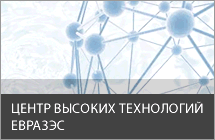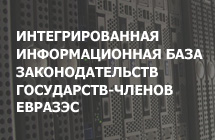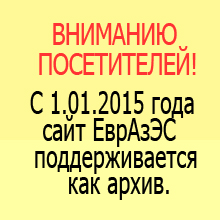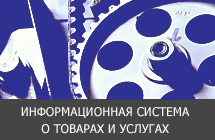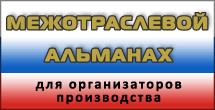|
AGREEMENT AGREEMENT on conducting coordinated policy with regard to technical standards, sanitary and phytosanitary measures AGREEMENT on conducting coordinated policy with regard to technical standards, sanitary and phytosanitary measures
Governments of Member States of the Eurasian Economic Community (hereinafter, EurAsEC) hereinafter referred to as Parties, Based on the unified principles to ensure the free movement of goods, To enhance integration processes in the Eurasian Economic Community and establish the Customs Union, Acknowledging the expediency of conducting coordinated policy with regard to technical standards, veterinary-sanitary and phytosanitary measures (hereinafter, sanitary and phytosanitary measures), Taking into account the rules and principles stipulated by the Agreement on Technical Barriers to Trade and the Agreement on Sanitary and Phytosanitary Measures of the World Trade Organization adopted at the Uruguay Round of Multilateral Trade Negotiations of April 15, 1994; Recognizing that no Party should be prevented from adopting or enforcing measures necessary to ensure the quality of its export, protection of human, animal or plant life or health, and prevention of any actions that might mislead consumers; and Seeking to eliminate any unjustifiable restrictions in mutual trade, Have agreed as follows:
Article 1
The terms used in this Agreement shall have the following meaning: “accreditation” means official recognition by the accrediting body of the competence of the body (laboratory) carrying out the assessment (certification) of conformity with requirements for the work in the specified area of such conformity assessment (certification); “safety” means the absence of unacceptable risk related to any potential of causing harm and/or damage; “state control” means an inspection by the authorized state body of any individual or legal entity involved in business activity of their technological regulation conformity, also maintaining sanitary or phytosanitary measures and taking follow-up measures on the inspections results; “Manifest of EurAsEC Technical Regulation Conformity” means a document used by the manufacturer (a person authorized by such manufacturer or seller) to prove the conformity of goods under distribution with the requirements of EurAsEC technical regulations; “conformity declaration” means a form used by the manufacturer (a person authorised by the manufacturer or seller) to confirm the conformity of goods under distribution with the requirements of EurAsEC technical regulations; “common customs area” means a territory comprising customs areas of Member States of the customs union; “common conformity marking for products of EurAsEC member states” means a sign to inform buyers (consumers) of the compliance of the goods under distribution with the technical regulations of EurAsEC; “international standard” means a standard adopted by an international organization; “authorized national body of the participating states” means state administration bodies of the Parties performing and/or coordinating efforts on technical regulation, and sanitary and phytosanitary measures; “national (state) standard” means a standard adopted by the national standardizing body of the Party’s state; “accreditation body” means a body or a legal entity authorized to provide accreditation pursuant to the state law of the Party; “conformity certification body (conformity assessment (confirmation) body)” means a body accredited and/or designated in accordance with the state law of the Party to certify the conformity; “conformity assessment” means determining directly or indirectly of the conformity with the requirements to the object of technical regulation; “confirmation of conformity” means a documentary certification that products or any other items, production processes, operation (use), storage, carrying (transportation), sale and recovery of products, performance of work or providing services conform with technical regulations, standards and other documents including product characteristics and processes related thereto, which may have voluntary or mandatory nature; “product” means the result of activity in a material tangible form and intended for further use for economic and other purposes; “regional standard” means a standard accepted by a regional standardizing organization, including the Interstate Council for Standardization, Metrology and Certification of the Commonwealth of Independence States (CIS) or the Interstate Science and Engineering Commission for Standardization and Technical Regulation of the Commonwealth of Independence States; “risk” means a combination of the possibility of causing harm and the consequences of such harm to human life or health, property, environment, animal or plant life or health; “sanitary and phytosanitary measures” means binding sanitary, veterinary sanitary and phytosanitary requirements and procedures introduced for the purposes of: protecting human and animal life and health against the risks arising from risks arising from additives, contaminants, toxins or disease-causing organisms in foods, beverages or feedstuffs and other products; protecting animal and plant life and health against risks arising from the entry, establishment or spread of plant pests, causative agents of plants and animals, plants (weeds), disease-sampling organisms, and pathogens which have a quarantine effect for the Parties’ countries; protecting human and animal life or health against risks arising from diseases carried by animals, plants or products made of them; preventing or mitigating any other harm caused by penetration, rooting (fastening) or spread of plant pests, plant and animal causative agents, plants (weeds), pathogens, including their carrying or spread by animals and/or plants with products, cargoes, materials, and transport, which have a quarantine effect for the Parties’ countries; “certificate of conformity with the technical standards of EurAsEC” means a document whereby the conformity certification body (conformity assessment (confirmation) body) certifies the compliance of products or other objects with the technical standards of EurAsEC; “certification” means a form of mandatory approval of conformity of products or other items with the technical standards of EurAsEC by the conformity certification body (conformity assessment (confirmation) body); “standard” means the document establishing, for the purposes of voluntary multiple use, the product performances, the rules for realization and the characteristics of processes of production, operation, storage, transportation, marketing and utilization, executing of works or rendering of services. The standard may also contain the requirements for terminology, symbols, packing, marking or labeling, and the rules for their affixing. The standard shall be accepted by common consent of the participants in such standard developing on principal matters. The standard and its relevant information shall be available to all persons concerned; “EurAsEC Technical Regulations” means a document adopted by the International Treaty of the Parties’ states within EurAsEC setting forth mandatory for use and binding requirements to the objects of technical regulation (products or product-related production, installation, setup, operation (use), storage, carrying (transportation), sale and disposal. The EurAsEC Technical Regulations may include rules and conformity assessment (confirmation) forms, identification rules, requirements to terminology, packing, marking and labeling and the rules of their application; “technical regulations” means government regulation of relations to develop and introduce technical regulation, standards; and perform maintained in accordance with international treaties and laws of the Parties’ states; “person authorised by manufacturer” means natural or legal person registered in accordance with the established procedure by the Party’s state, and which is designated by the manufacturer under the contract with such person to take actions on the manufacturer’s behalf provided there are declarations of conformity and products placement in customs areas of the Parties’ states, and to impose responsibility for non-compliance with the technical regulations of EurAsEC.
Article 2
1. The Parties shall conduct coordinated policy of technical regulation, sanitary and phytosanitary measures by means of: а) introducing measures required for harmonization of the Parties’ state laws; b) developing and accepting technical regulation of EurAsEC stipulating mandatory and binding requirements to the objects of technical regulation; c) ensuring the unity of mandatory requirements to the object of technical regulation within the Party’s state; d) adopting the unified rules to carry out technical regulation, develop sanitary and phytosanitary measures for the purposes of ensuring the necessary level of sanitary, veterinary, and phytosanitary safety in the territory of the Parties’ states; e) harmonizing standards; f) applying the unified forms and rules of conformity assessment; g) harmonizing conformity assessment procedures; h) developing and applying comparable test methods (measurement and control) for conformity assessment (confirmation) of products or product-related production processes, installation, setup, operation (use), storage, carrying (transportation), sale and disposal; ii) accrediting and/or designating certification (conformity confirmation) bodies and accrediting test laboratories (centres) participating in the process of mandatory confirmation of conformity. 2. For the purposes of implementing the provisions of this Agreement, the Parties shall provide the relevant authority to the state administration bodies of the Parties’ states, which conduct and/or coordinate technical regulation, sanitary and phytosanitary measures. 3. The Parties’ national state bodies vested with such authority shall take measures to protect the territory of each Party’s state from epidemics and epizootics, and also to prevent: spreading of human and animal diseases; spreading of plant pests, causative agents of plants and animals, and plants (weeds), which have a quarantine effect for the Parties’ countries from the territory of one of the Parties’ states to the territory of any of the Parties’ states.
Article 3
The Commission for Technical Regulation and Sanitary, Veterinary and Phytosanitary Measures in Trade of the EurAsEC Integration Committee shall coordinate the efforts on technical regulation, sanitary and phytosanitary measures in accordance with the international treaties of the Parties’ states. The authorized national bodies of the Parties’ states or authorized bodies of the Parties’ states on their behalf shall enter into consultations with the aim to coordinate the positions of their states on accrediting, harmonization of national (state) standards regarding the products subject to mandatory conformity assessment (confirmation), and the procedures of conformity assessment (confirmation). The authorized national bodies of the Parties’ states shall enter into consultations on the matters of technical regulation and elaborations of technical standards with other interstate associations with the aim to harmonies the mandatory requirements to products.
Article 4
1. The Parties shall recognize: а) national (state) standards identical to international and regional standards which conform to international standards, guidelines and recommendations with respect to sanitary and phytosanitary measures, except when such documents are irrelevant to the purposes of technical regulation, including due to the effects of climatic and geographic factors or technology problems; b) national (state) measurement standards which meet the conditions of the International Metric Convention of May 20, 1875 and which have been subjected to mutual comparison; c) documents to confirm the conformity issued by the conformity certification body (conformity assessment (confirmation) body) and test laboratories (centers) of the Parties’ states, if not inconsistent with the provisions of Item 2 of this Article; d) rules, procedures and conformity assessment (confirmation) results applicable within the territory of the Parties’ states, if not inconsistent with the provisions of Item 2 of this Article; e) the results of state control (supervision) of compliance with the technical standards of EurAsEC. 2. The Parties based on separate agreements shall recognize: Accreditation certificates issued by the accreditation bodies Rules and procedures of accreditation introduced within the territory of the Parties’ states which conform with the requirements of international standards. Article 5 1. Technical regulations of EurAsEC shall be adopted for the purpose of protecting the life or health of people, property, environment, animal and plant life or health, and preventing actions that might mislead consumers. Adoption of technical regulations of EurAsEC for any other purposes shall not be allowed. Technical regulations of EurAsEC shall be binding upon the Parties’ states and shall be subject to introduction within the territories of the Parties’ states in accordance with the procedure provided for by their laws. 2. The basis for elaborating of the EurAsEC Technical Regulation shall be the relevant international standards, requirements and other documents (rules, directives and recommendations accepted by international standardizing organizations or any other documents), and if they are unavailable, regional document (regulations, directives, decisions, standards, rules and other documents), national (state) standards, national technical regulations or their drafts in their final version, except when such documents are irrelevant to the purposes of technical regulation, including due to the effects of climatic and geographic factors or technology problems. 3. The International Treaty on acceptance of EurAsEC technical regulation shall be ratified in accordance with the procedure established by the laws of each Party’s state. 4. The procedure for elaboration and adoption of EurAsEC technical regulations shall be defined by a separate agreement of the Parties. Article 6
1. The products covered by the technical regulation (technical regulations) of EurAsEC shall be distributed within the territory of each of the Parties’ state, provided that such products have been assessed (confirmed) for conformity within the territory of the state of each of the Parties. Conformity assessment specified in EurAsEC technical regulations shall be conducted in the form of registration, testing, confirmation of conformity (conformity declaration and certification), evaluation, government control (supervision), and in any other form. Mandatory conformity assessment (confirmation) shall be carried out only in cases stipulated in the relevant EurAsEC technical regulations, and only with regard to the conformity with their requirements. The rules of conformity assessment (confirmation) at the stage of product distribution in the form specified in EurAsEC technical regulations may be governed by the laws of the Party’s state, if it is provided for by EurAsEC technical regulation. The unified forms of documents on conformity assessment (confirmation) shall be established by a separate agreement of the Parties. The mandatory conformity confirmation of the products under distribution with the requirements of EurAsEC technical regulations shall be issued prior to distributing products. The Parties shall ensure the distribution of products which conform to EurAsEC technical regulations within the territory of their states without imposing any requirements supplementary to those included in EurAsEC technical requirement to the products, and without any additional procedures of conformity assessment (confirmation), unless otherwise provided herein. In this case, no rights of each state of the Parties for state control (supervision) shall be limited, including their rights regarding the application (observing) of sanitary and phytosanitary measures. State control (supervision) shall be carried out in accordance with the procedure stipulated by the law of the Party’s state. 2. Upon mutual consent of the Parties, international and regional standards, and in case they are unavailable – national (state) standard of the Parties’ states, shall be used for conformity assessment (confirmation) of the products’ observance of EurAsEC technical regulations. For the above purposes, the Parties shall draw up the relevant list of standards. 3. The Parties shall ensure the application of a common conformity marking for products of EurAsEC Member States with regard to products under distribution and conforming with the requirements of EurAsEC technical regulations. The procedure for elaboration and application of a common conformity marking for products of EurAsEC Member States shall be established by a separate agreement of the Parties.
Article 7
1. The documents on conformity assessment (confirmation) of products in respect of which EurAsEC technical regulation is accepted, issued by a certification body of one of the Parties’ states shall be equally valid within the territory of the Parties’ states without carrying out of additional conformity assessment (confirmation) procedures. 2. Prior to implementing EurAsEC technical regulations, products in respect of which the Parties establish mandatory equal requirements, and equal forms and procedures of mandatory conformity assessment (confirmation) – conformity declaration and/or certification – are eligible for distribution within the common customs area, if they have passed the established procedures of conformity assessment (confirmation) within the territory of any state of the Parties.
Article 8
1. The Parties shall harmonize the national (state) standard and ensure the observation of the following principles: а) voluntary application of standards; b) publicity and transparency of the standards development processes; c) availability of national (state) standards and information regarding the procedure for their development, acceptance (approval) and publication; d) application of the international standards as the basis for drafting national (state) standards, except when such documents are irrelevant to the purposes of technical regulation, including due to the effects of climatic and geographic factors or technology problems; e) inadmissibility of accepting (approving) standards which are inconsistent with EurAsEC technical regulations. 2. The Parties shall give a priority (advantage) to accepting national (state) standards harmonized (identical, above all) with international and regional standards. Article 9
Upon the request by the authorized national bodies of the Parties’ states, the relevant authorized national bodies of other states of the Parties shall submit documents of conformity assessment (confirmation). Confidential information shall be provided in accordance with the procedure established by the agreement, which the Parties’ states are parties to. 2. The documents of conformity assessment (confirmation) received outside the common customs area, including documents regarding test results and products imported for distribution within the common customs area, shall be recognized, only in case all states of the Parties have acceded to the relevant international treaties.
Article 10
The Parties shall ensure that sanitary or phytosanitary measures are applied only to the extent necessary to protect human life or health, property, environment, animal or plant life or health, are based on principles which have satisfactory scientific evidence, and international and regional standards, guidelines and/or recommendations, except when such documents are irrelevant to the purposes of technical regulation, including due to the effects of climatic and geographic factors or technology problems. In cases where the urgent application of sanitary and phytosanitary measures is required, and relevant scientific evidence is insufficient or cannot be obtained in proper time, the sanitary and/or phytosanitary measures regarding specific types of products may be applied by the authorized national bodies of the Parties’ states on the basis of available information, including that from the relevant international organizations, foreign states, as well as from sanitary or phytosanitary measures applied by other states or any other information. Sanitary and phytosanitary measures may include conformity verification of products, methods of their processing and production, test procedures, inspection, conformity assessment (confirmation), quarantine rules, in particular, the requirements related to transportation of animals and plants, materials needed to ensure animal and plant life or health during their transportation, and methods and procedures of sampling, and methods of research and risk assessment. As soon as possible the Parties shall notify each other of any application and introduction by them of sanitary and phytosanitary measures and any changes to them.
Article 11
The Parties shall elaborate and apply sanitary and phytosanitary measures on the basis of scientific evidence, and taking into account the relevant international standards and recommendations and any other documents of international organizations with the aim of observing the appropriate level of sanitary, veterinary sanitary and phytosanitary protection which is defined with due consideration of the scientific level of risk. The above measures shall ensure to the Parties’ states the level of protection which is no less than the level provided for by the law of any Party’s state. While assessing the risk level, the Parties shall take into account the following factors: a) provisions of international standards, recommendations and/or guidelines of international organizations; b) information on human or animal disease spread; c) information on spreading of pests, disease-carrying organisms or disease-causing organisms; d) environmental conditions; e) economic effects related to the potential causing of harm; f) amounts of expenses to prevent the causing of harm and measures taken by suppliers to control plant pests, animal and plant disease-causing organisms (weeds), or disease carrying organisms. The matters of reciprocal recognition in the area of sanitary and phytosanitary measures of EurAsEC Member States shall be settled by separate agreements of the Parties.
Article 12
1. The authorized national bodies of the Parties’ states shall: а) inform each other of conformity the certification bodies (conformity assessment (confirmation) body) and test laboratories (centers), and accreditation bodies of their states; b) exchange information on standardization, including the developed and applicable national (state) standards, and coordinate their efforts in this field; c) advise each other of products inconsistent with EurAsEC technical regulations, revealed during conformity assessment (confirmation and in the process of state control (supervision). 2. EurAsEC information system for technical regulation, sanitary and phytosanitary measures (hereinafter, EurAsEC information system) shall be created for exchanging information. The procedure for establishing and operation of EurAsEC information system shall be defined by a separate agreement of the Parties. 3. The Parties shall create (designate) national information centers for technical regulation, sanitary and phytosanitary measures in their states, take measures to ensure their operation, and provide data to EurAsEC information system. 4. Authorized national bodies of the Parties’ states, when revealing in the process of conformity assessment (certification) or state control (supervision) any inconsistency with EurAsEC technical regulations of products, in particular those imported from the third states, or with mandatory requirements of their own Party relative to products which are not covered by EurAsEC technical regulations, and referring the products under distribution to products posing hazards to human life or health, property, environment protection, and animal or plant life or health, shall without any delay, (or simultaneously with identifying such inconsistency or revealing any hazardous products) submit the relevant data to EurAsEC information system, notify the authorized national bodies of the Parties’ states thereof, and take measures to prevent such products from entering the territory of the Parties’ states.
Article 13
The authorized national bodies of the Parties’ states shall fulfill state control (supervision) to ensure meeting EurAsEC technical regulations, sanitary and phytosanitary measures in accordance with the law of their state, unless otherwise provided by international treaties related to this field.
Article 14
Disputes related to the application and interpretation of this Agreement shall be settled by way of consultations and negotiations between the Parties, and if the Parties fail to reach an agreement, such disputes shall be referred to the Court of the Eurasian Economic Community. Article 15
By agreement of the Parties, this Agreement may be amended, and such amendments shall be executed by separate protocols.
Article 16
This Agreement shall be enforced as of the date of receipt by the depository of the third written notification that the Parties have performed all domestic procedures necessary for the enforcement hereof.
Done in the city of The original copy of this Agreement shall be deposited with the Integration Committee of the Eurasian Economic Committee, which as the depository of this Agreement shall provide each Party with its notarized copy.
For the government of the For the government of the For the government of the For the government of the For the government of the
|
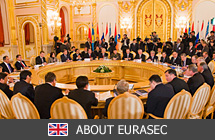
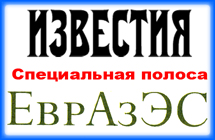
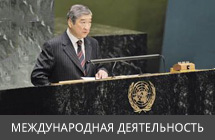

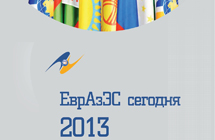
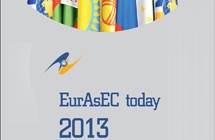
Поиск 10.10.2014 Заседание Межгосударственного совета ЕврАзЭС07.10.2014 Мультимедийная пресс-конференция в агентстве «Россия сегодня»03.10.2014 Встреча с Послом Финляндской Республики04.08.2014 Встреча Генерального секретаря ЕврАзЭС с Послом Республики Таджикистан20.06.2014 Премии Петербургского международного юридического форума «За вклад в развитие правовой интеграции на евразийском пространстве»28.05.2014 Договор о Евразийском экономическом союзе – важнейшее событие в новейшей истории наших стран25.05.2014 Презентация книги «Евразийский проект Нурсултана Назарбаева, воплощенный в жизнь. К 20-летию евразийского проекта 1994–2014»24.05.2014 VII АСТАНИНСКИЙ ЭКОНОМИЧЕСКИЙ ФОРУМ. Панельная сессия «Евразийской экономической интеграции – 20 лет. Итоги и перспективы»24.05.2014 VII Астанинский экономический форум и II Всемирная Антикризисная конференция, 21-23 мая 2014 года, Астана24.05.2014 Петербургский международный экономический форум, 23 – 24 мая 2014 года, Санкт-Петербург |

Евразийское экономическое сообщество
ЕврАзЭС
-
Страны участники
 Беларусь
Беларусь
-
 Казахстан
Казахстан
-
 Кыргызстан
Кыргызстан
-
 Россия
Россия
-
 Таджикистан
Таджикистан
-
 Узбекистан
Узбекистан
-
 Молдова
Молдова
-
 Украина
Украина

